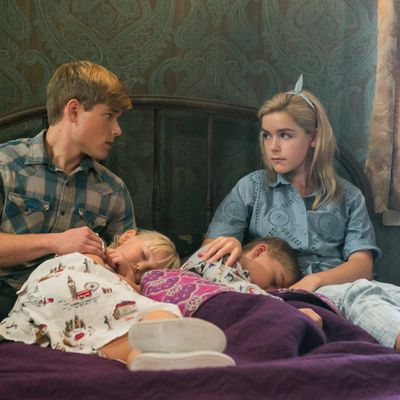
All in all, Lifetime’s adaptation of Flowers in the Attic, which aired over the weekend, turned out to be a lot more faithful to V.C. Andrews’s gothic teen incest classic than the high camp — if ultimately chaste — 1987 film starring a young Kristy Swanson, which nixed the all-important brother-sister romance, just to start. The new adaptation’s writer, Kayla Alpert (Up All Night, Ally McBeal), who, hidden away from her parents, devoured the book in junior high under her Laura Ashley comforter, kept in most of the novel’s most taboo and outrageous delights — sibling sex, grandmotherly whippings, poisoned doughnuts (never cookies!) — but also says she felt compelled to make a few tweaks to amp up the stakes if not the melodrama. “We didn’t want it to be a total campfest,” she said. Here, Alpert discusses with Vulture the biggest differences between the TV movie and the book.
No penis-measuring, no blood-drinking. On the spectrum of psychological horror, Alpert says she wanted to take the story tonally away from Mommie Dearest and toward Rosemary’s Baby. To do that, she nixed most of Andrews’s flowery, formal dialogue as well as some of the novel’s more absurd moments. Grandma still pours tar in Cathy’s hair because she’s righteous and vicious, but Chris and Cathy are afforded a little more common sense. For example: Chris doesn’t try to revive his weakened brother Corey by making him drink blood, nor does he get stuck explaining why he’s taking stock of his penis to Cathy. “The book is great but it’s not perfect,” Alpert laughed. “It tends to go up and down with how much Cathy knows and doesn’t know. In some ways, she’s very wise and emotionally savvy; in other ways, she’s overly sexually naïve. We had to even it out a little bit. When you try to dramatize someone measuring their penis and someone walking in on it, it could wind up being a little bit silly. ”
Chris doesn’t rape Cathy. In the book, Cathy steals a kiss from her mother’s sleeping fiancé, sending Chris into a jealous rage that ends in rape. Alpert changed it to Chris angrily shaking his sister and immediately feeling bad about it. Then they sleep together. The rape scene was in the original script, but both Lifetime executives and Alpert felt it didn’t belong (this well before a then-13-year-old Kiernan Shipka was cast as Cathy). “It comes out of nowhere in the book,” Alpert explained. “He rapes her, and on the next page she’s comforting him and in love with him. To be totally honest, I actually felt like it wasn’t earned. Like, if I was giving notes to V.C. Andrews, I would have said that felt very strange. It’s hard to root for Chris again after that happens.”
Grandmother’s bitter backstory. Ellen Burstyn found it difficult to empathize with Olivia, who in the book is a Bible-toting witch who has been furious for the twenty years since her daughter Corrine married the stepbrother of Olivia’s husband (basically, Corrine’s step-uncle). Alpert created a better explanation, and calls it “the biggest change we made … Ellen wanted to broaden and deepen the character, so we went to the drawing board and came up with more of a reason why the relationship between Olivia and Corrine was so fraught.” Alpert focused on an idea briefly hinted at in the book that Olivia had long been jealous of the attention her husband lavished on their daughter. When she whips Corrine in the movie, for example, Olivia explains it’s not just for her illicit marriage, but for “every year she used her wicked charms on my husband.” Another scene was added in which Olivia’s old wounds are reopened when her ailing husband gifts his prodigal daughter with an expensive necklace in front of everyone during a party.
Cathy and Chris encounter a friendly fawn. In a sequence invented for the movie, Cathy and Chris get close to a deer on the Foxworth grounds after they escape for a swim in the lake. Later, they watch the animal get shot from their attic window, and an electric fence is installed around the property, making an escape look even more hopeless. “The kids basically make a copy of the key and walk out in the book. Not the most dramatic ending for a movie,” Alpert said. “We needed to create some external obstacles and stakes, and also a metaphor for who they are, these young fawns getting destroyed in this house. Seeing the deer die, they understand what happens to them if they don’t leave.”
Olivia gets trapped in the attic. Andrews’s ending is pretty anticlimactic: The kids leave while their grandma is asleep, and long after their mother has abandoned them. Alpert thought Olivia deserved some comeuppance, and wrote in a small triumph for the kids in which Chris traps the claustrophobic Olivia in the attic on their way out. “We decided it would be more satisfying if the kids exploited her one weakness to their advantage,” Alpert said. At the same time, she made sure grandma got the last word: In the TV movie, she gets to reveal the devastating truth about their mom poisoning them with arsenic to ensure the terms of her father’s inheritance. “Even though the kids are escaping victoriously, grandma can’t let them get away unscathed — at least psychologically,” Alpert said. “And of course, we wanted to give Ellen Burstyn something juicy, and she nailed it.”




